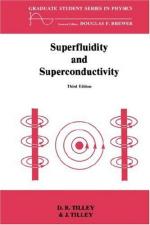|
This section contains 801 words (approx. 3 pages at 300 words per page) |

|
Superfluidity refers to a transition that occurs in the properties of liquid helium at a temperature of 2.17K, called the lambda point of helium. A discontinuity in heat capacity is observed, the density of the liquid is decreased, and a fraction of the liquid helium becomes a superfluid, i.e., a zero viscosity fluid that exhibits an extraordinarily enhanced fluidity through any medium.
In its elemental state, helium is a gas that can occur as two isotopes, helium-4, which is the most common, and helium-3, which occurs only in very small amounts. Helium-4 has a nucleus consisting of two protons and two neutrons surrounded by two electrons, which is the definition of a boson, i.e. a species consisting of even numbers of elementary particles. The helium-3 nucleus however, has only one neutron and is therefore termed a fermion because it consists of an odd number of spin-...
|
This section contains 801 words (approx. 3 pages at 300 words per page) |

|


